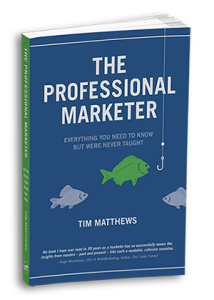Estimated Reading Time: 3 minutes
 Sometimes you hear something and think, “I heard that five years ago. Ten years ago. How is that still a problem?” Now, I’m not talking about global warming or peace in the Middle East. No, I’m in marketing world here, and specifically, talking about the old saw “sell solutions, not products.”
Sometimes you hear something and think, “I heard that five years ago. Ten years ago. How is that still a problem?” Now, I’m not talking about global warming or peace in the Middle East. No, I’m in marketing world here, and specifically, talking about the old saw “sell solutions, not products.”
Marketers have been told to focus on solutions countless times. So why are marketers are still focusing on product? We marketers are human, after all, and the problem with adages like this is that people tune out when they hear them. But the adage is still true. How do we change?
Let’s take a different tack on the maxim, and substitute problems for solutions. Rewriting the maxim, it becomes “write about problems, not products.” Here’s how you put it into practice.
For those who are building websites or writing blogs, I want you to think about how you can make your copy problem-oriented, rather than product-oriented. Online, buyers are searching for ways to solve their problems, and your content should answer their search. Save the product content for further down the funnel, after you have hooked them.
The need for problem-oriented content struck me in a recent sales training session, where the trainer was teaching sales reps to dig down below what he called “level one pain.” Level one pain is a buyer’s technical, or literal, problem. The WiFi router is not showing up on my iPad, for example. Level two pain – going a level deeper, he explained – is the the buyer’s business problem. If I can’t connect my iPad to the WiFi, I can’t check my email. The third level of pain is personal pain. What happens if the buyer doesn’t solve that business problem? If I can’t read my email, I can’t respond to my boss, and he will think I’m not doing my job.
Think about your buyers, and their personal pain. Do they never see their family because they are always working? Do they get fired for not doing their job? Do they not get a promotion? Understanding their ultimate personal problems will allow you to create poignant content, as opposed to bland stuff about your product. Running a marketing team, I find substituting problems for solutions makes for a more clear-eyed discussion on content strategy.
Bought in and ready to adopt the problem-first mindset? Here’s how.
Step one: Take a look at your website. Maybe you’re already writing problem-oriented content, in which you case you can stop reading this blog and go do something more productive. I have no problem I can solve for you. If, however, you notice that your website is all about your products, then read on.
Step two: Figure out what the problems are that your buyers are trying to solve. What is their pain? Don’t stop at level one; go all the way to personal pain. There are many ways to do this. You can, knowing your buyers, conduct buyer persona interviews and ask your buyers directly, “What are your most pressing problems?” You can ask your salespeople, “What are the business problems that our customers are trying to solve? What was at risk for them if they didn’t solve their business problem?”
Step three: With the list that you’ve ever gleaned from customers or salespeople, write out some problem statements. What’s to be gained from solving these problems? Then take a look around. Do your own manual searches. Use SEO tools to look at search volumes or search patterns or trends around phrases associated with these problems. Then, with that thorough understanding, boil it down to two, three, four, no more than five problems that you solve. It’s unwieldy for a team if you have more. Take a look at your home page and figure out a new design or just new copy that address the top problems. Then look at your blog and constant calendar and next to your content is aimed at solving those problems.
Step four: Conduct some A/B testing. Use a product like Optimizely on your homepage, and if you’re not sure which of those problems is the biggest try them all out. See which one causes your conversion rates to increase. I would say if none of them do, then perhaps you haven’t really figured out the problem that you solve for your buyers.
Getting inside the mind of your buyers, figuring out their problems, and figuring out how to address those problems with problem solving content on your website should all you to have a more productive website and, ultimately, sales force. If you continue putting product in front of problem in your marketing, you might experience some level three pain yourself.
How about you? Is your content problem oriented?
 Want to learn even more about marketing?
Want to learn even more about marketing?